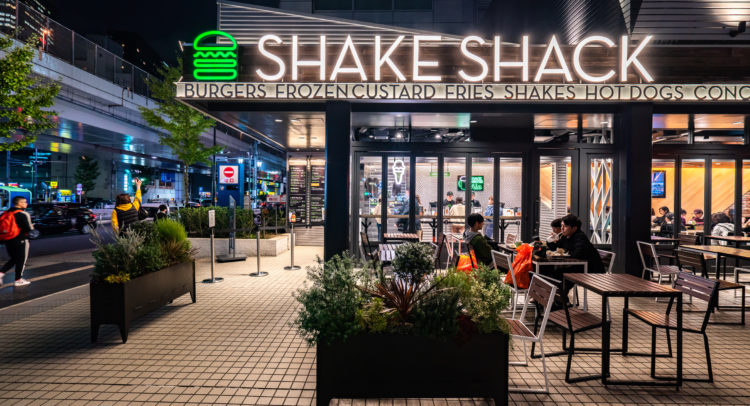Shake Shack (SHAK) may be a trendy establishment for hamburgers, but its performance certainly hasn’t been trending in the right direction.
Don't Miss Our Christmas Offers:
- Discover the latest stocks recommended by top Wall Street analysts, all in one place with Analyst Top Stocks
- Make smarter investments with weekly expert stock picks from the Smart Investor Newsletter
Severely outperformed by the S&P 500, with a roughly -40% return over the last year compared to a 16% return of the S&P 500, it is evident that Shake Shack continues to be plagued by both new and existing issues resulting from inflation and the COVID-19 pandemic.
To ameliorate this situation, the company has outlined a strategy based on the four pillars of investing in staff, exploiting digital channels, evolving existing formats of delivery, and enhancing the consumer experience.
While these efforts seem positive, the extensive cost of such initiatives in conjunction with the rising costs of commodities may perpetuate the near all-time low margins and returns on investments Shake Shack endures.
Shake Shack aims to be a modern “roadside” burger stand serving high-quality versions of the quintessential American menu items, such as hamburgers, chicken sandwiches, and French fries. Along with its commitment to fresh ingredients, the company also prides itself on its emphasis on caring hiring practices and treatment of employees as well as the community in which it operates.
Opening in New York City in 2004, the company has grown to over 240 domestic locations and more than 125 international locations, including London, Hong Kong, and Dubai.
I’m neutral on Shake Shack.
Unhealthy Financials
While the public may enjoy Shake Shack’s premium offerings, investors’ appetites may not be satisfied when analyzing the company’s financials.
Current operating and net margins are -1.9% and -2.6%, respectively, with a return on equity and return on assets of -4.4% and -1.4%, respectively. This trend also continues into the firm’s economic profit, which reveals the firm is destroying value through its capital management.
When computing the difference between the return on invested capital and the weighted average cost of capital, the current economic profit is -14%; over the last several years, this metric has been negative and declining, which is certainly worrying.
The negative outcome of these investments is also evident in the declining revenue growth of the company. The current three-year revenue growth rate is a mere 0.5%, and EBITDA has dropped from $67.4 million in 2018 to $42.9 million in the trailing 12 months.
On the contrary, though the strategy of Shake Shack is founded heavily upon investments and growth, the company’s current ratio is 3.5x, which is generally better than the industry.
Turning toward Q4 and full-year 2021 guidance, Shake Shack recently released preliminary and unaudited results.
In Q4, total revenue increased 29% versus the same period in 2020; however, this is a decrease compared to Q3 2021, in which revenue increased 48.7%. Similarly, “shack sales,” or the sales at domestic company-operated Shacks excluding licensed locations, increased 28.5% compared to the previous year. This can partially be attributed to the opening of 19 new locations in Q4.
With respect to the 2021 Fiscal Year, total revenue increased 41.5% compared to 2020, with same-shack sales increasing 24.2% compared to the previous year. Consequently, the revenue from both company-operated and licensed locations also increased 41.2% and 50.7%, respectively, compared to 2020.
Maintaining a positive outlook toward overcoming previous performance issues, CEO Randy Garutti explained, “We are pleased with the continued recovery we saw in the fourth quarter of 2021, outpacing historical seasonality, with average weekly sales of $74,000 compared to $72,000 in the third quarter of 2021.”
Despite this, CFO Katie Fogertey also recognized the continuing threats the company is facing, stating, “While we are pleased by the fourth quarter, we also saw our operating hours drop in the last week of Fiscal Year 2021 and the first two weeks of Fiscal Year 2022… We expect these trends to continue to impact our company-owned Shacks and our licensed business.”
However, she remains hopeful that their new initiatives will mitigate the consequences of such threats.
Taking New Forms
Like many other businesses, Shake Shack is adopting an omnichannel experience, transforming the traditional sit-down atmosphere of its locations into online driven or drive-thru locations, thus creating new opportunities to reach customers and improve their experience.
In 2021, Shake Shack launched a new website and Android app to enhance the ordering process. Not only has merchandising and marketing been proliferated, but while ordering, upsell tactics have been integrated, luring customers to purchase additional items they may not have initially desired.
This method also enables customers to receive their orders in various forms, such as indoor pick-up, curbside, or the new walk-up window – a spinoff of the drive-thru.
Despite these new channels, Shake Shack is also introducing and depending heavily upon standard drive-thrus, which the business has lacked.
Rather than adding drive-thrus to existing locations, Shake Shack has opened new locations that solely offer drive-thru service. With an obvious focus on convenience, this more capital-friendly approach, combined with the new app and electronic signs to highlight menu items, certainly has the potential to attract more customers.
To facilitate this rapid growth, Shake Shack has turned to licensing.
Partnering: Exploiting the Experience of Others
Similar to a franchise model, Shack Shake establishes relationships with operators who have experience expanding global brands. Not only does this allow the risks to be shared by both the company and licensees, but new markets are both reached and tailored to.
Throughout 2022, 20-25 new licensed locations are expected to open, adding to the 26 licensed locations that opened in 2021 and targeting global markets such as Mexico and China. Additionally, Shake Shack has also inserted itself into three major airports, unlocking yet another opportunity for growth and working toward establishing economies of scale.
While these initiatives suggest the company is moving in the right direction, it still may be “too little, too late,” with an uphill journey ahead.
Wall Street’s Take
Wall Street seems to recognize both the company’s promise and uncertainty, currently placing a Hold rating on SHAK based on four Buys, 11 Holds, and two Sell ratings assigned in the past three months.
The average Shake Shack price target of $87.07 implies 31.6% upside potential, with a high of $118.00 and a low of $70.00.

Conclusion
In a crowded industry, Shake Shack has created menu offerings consumers enjoy and should be respected for its social efforts, but the quality of its business strategies and ability to create shareholder value is questionable.
One could hope that such growth measures and improvements can overcome recent shortcomings, but the precedent Shake Shack has built does not likely instill much confidence in investors.
Download the TipRanks mobile app now
To find good ideas for stocks trading at attractive valuations, visit TipRanks’ Best Stocks to Buy, a newly launched tool that unites all of TipRanks’ equity insights.
Read full Disclaimer & Disclosure



















